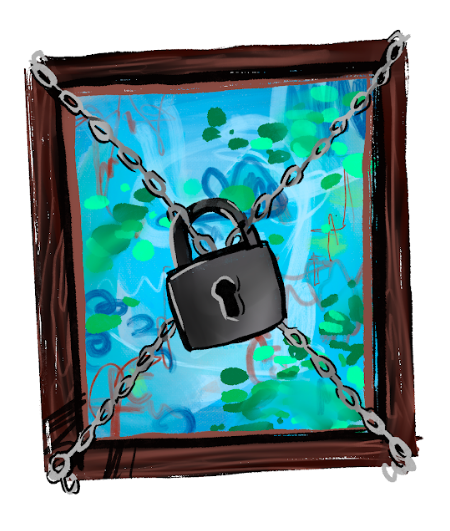Rumor has it that there is more to Deerfield art than can be seen on the surface. There is said to be a top secret art vault on campus, kept secure by elaborate mechanisms of security in an unknown location. It supposedly contains pieces by renowned artists who leave behind gifts after displaying their work. Supposedly among the collection lies an Andy Warhol piece that is worth millions. But are these stories true? Does this mysterious vault exist? Is there really an entire world of art that Deerfield has yet to disclose to the public?
Unfortunately it must be confirmed that Deerfield does not, in fact, possess an undercover vault protecting the multi-million dollar work of Warhol and others. The designated art storage area on campus is located below the Black Box Theater of the Hess. It is climate and temperature controlled and equipped with an alarm, yet does not nearly contain as much art as is currently displayed on campus.
The majority of the art Deerfield owns — alumni gifts and collectibles — are placed throughout campus with the philosophy that what is acquired must be hung up. Visual and Performing Arts Chair Lydia Hemphill, the principal manager of Deerfield art storage, said, “What’s in storage is really far less interesting than the fact that we actually have a collection– not every school has such holdings.”
In her 2019 article “Secret of the Manse,” Helen Mak ’20 introduced us to the Charles. P. Russell collection, a gift from two sisters in memoriam of their father from the 1950s. The collection serves as the central representation of Deerfield-owned art, and most of it is displayed in the Manse, in which Head of School Dr. Austin currently resides with his family.
In the 1960s, a group of Deerfield students formed the American Studies Group, whose name has no relation to the academic course, with the mission of exploring the educational resources offered by Deerfield’s unique location and studying the art of the surrounding Pioneer Valley.
As written by Chairman Christopher Beach ’69, the group was “one of Deerfield Academy’s most active organizations, providing an excellent opportunity for students to do original research and to experience the satisfaction of study in art and history.”
In addition to many other impressive investigations of Deerfield art, the group wrote and compiled a catalog of the various works of the Charles. P. Russell collection. Beach wrote, “All art is relative to history, and to instill a better understanding of the collection, biographical, historical, and critical material has been combined in the catalog.” The catalog was published in 1969.
Indeed, the collection presents a captivating world of history and culture, and the catalog has served as a useful resource for Spouse of the Head of School Monica Matouk in learning about the individual pieces displayed in her home, the Manse.
In her personal research, she has also explored the broader historical significance of the Manse in the development of the arts in Historic Deerfield, and pointed out previous homeowner of the Manse Madeline Yale Wynne as a key player in the arts and crafts movement. Wynne, who was a painter, writer, and jewelry maker, purchased and refurbished the Manse in the late 1800s. “I just love that the Manse has its own artistic role to play in the area,” said Ms. Matouk.

Former Head of School David M. Pynchon described the Russell collection as joining the rich array of art in the larger town of Deerfield, a significant addition to the artistic movement spearheaded earlier by Wynne and others. “The Town of Deerfield… has a unique atmosphere in which boys can live and study, and these paintings… become a part of the living heritage of the school, the town, and the entire community,” wrote Mr. Pynchon as the introduction of the catalog. “It was the ladies’ desire, and it is our hope, that everyone will take advantage of and share in the rich experience of the Russell collection.”
Ms. Matouk expressed her gratitude to be surrounded with such magnificent works. She said of the Russell collection, “It forces you to look. That’s what art does. It makes you slow down and snap out of your automatic way of relating to your everyday life and just look at something the way each artist spent hours looking at their own object, so there is that sense in the Manse that you’re invited to inhabit all these different perspectives.”
In previous years, the artwork of the Manse has generally been open for viewing by invitation, and has been an annual field trip destination for Ms. Hemphill’s Art History class. Dr. Austin and Ms. Matouk hope to extend the privilege of viewing the Charles P. Russell collection to the greater school community as soon as COVID-19 protocols allow.

